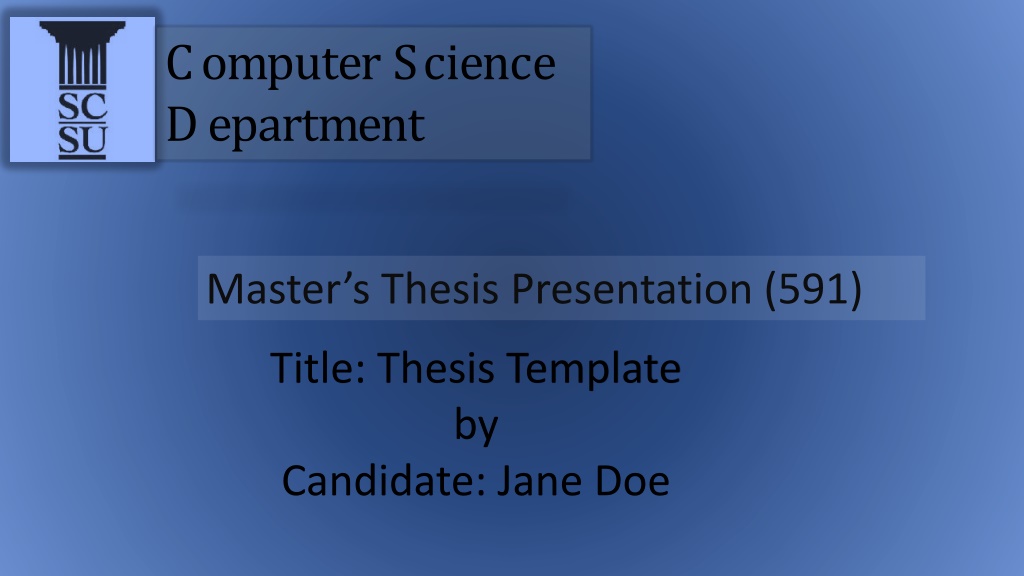Thesis Template for Computer Science Master's Thesis Presentation by Jane Doe
This template provides a structured outline for a Computer Science Master's thesis presentation, including sections on Introduction, Literature Review, Design, Methodology, Implementation, Results and Conclusions, Contributions, Future Work, and References. It emphasizes clear writing in IEEE format, thorough literature review, and addressing the presented problem efficiently.
Download Presentation

Please find below an Image/Link to download the presentation.
The content on the website is provided AS IS for your information and personal use only. It may not be sold, licensed, or shared on other websites without obtaining consent from the author. Download presentation by click this link. If you encounter any issues during the download, it is possible that the publisher has removed the file from their server.
E N D
Presentation Transcript
Computer Science Department Master s Thesis Presentation (591) Title: Thesis Template by Candidate: Jane Doe
Computer Science Department Title: Thesis Template Advisor 2nd Reader ChairPerson : : : Jane DaProf, Ph.D. John DaRead, Ph.D. Jane LaProf, Ph.D.
Contents: 1. Introduction 2. Literature Review 3. Design 4. Methodology 5. Implementation 6. Results and Conclusions 7. Contributions 8. Future Work 9. References
1. Introduction o The Section titles (on the previous slide) are tentative o This Section could be also called Problem Definition or Problem Specification
1. Introduction o In this Section you would gently introduce the issue you are planning to address. o Start with the Background of the Problem o Describe the Problem is some detail
1. Introduction o Provide some current solutions. o End this Section with the paragraph stating that your project addresses (solves) this introduced problem in some efficient manner
1. Introduction o While writing make sure that the Thesis is readable; having a smooth segue from one paragraph to another
1. Introduction o You are writing a scientific paper in IEEE format o Each statement must be either: i. A common knowledge ii. A fact presented in another paper (reference to that paper needed [1]) iii. A fact that is proven by your narrative
2. Literature Review o This Section can be called State of the Art . o In this section review each paper/document that you think is related to your problem and/or solution. o Present only papers that are relevant and if possible very recent.
2. Literature Review o Google Scholar is a good source [2]. o Ask your advisor to obtain copies of papers that you need. o Reviewing Web online content is also desirable. (Especially software libraries and tools).
3. Design o In this Section you would address the idea/concept of the solution for your research problem o Typically you would develop a system with underlying modules.
3. Design o Describe the system specifications o Describe the modules functionalities. o Do use graphics to depict the system.
3. Design Figure 1. my System Design (deliberately blurred)
3. Design o Describe each module from the graphics. o Create additional diagrams: UML, Visio .
4. Methodology o In this section you would discuss the methods on how you would proceed with developing your system as a solution to your problem. o How do you plan to develop the system and its modules?
4. Methodology o For each module (from 3. Design) explain how you plan to develop it so it satisfies all the requirement specifications. o Any specific Platform, Hardware, API used.
5. Implementation o In this section you would discuss the technical details of your implementation o List your implementation platform details o Discuss pieces of your code. There is no need to discuss all the code: Select only important and interesting code snippets to discuss
5. Implementation o Did you encounter any difficulties: list and discuss those. Also describe how did you overcome the technical obstacles. o Describe code runs and types of code tests. o Code manual/usage pages would be useful
5. Implementation To calculate z we use calculate() function: x = 3 y = 4 z = calculate(x,y) Figure 2. my Function Call (deliberately ambiguous)
6. Results and Conclusion o Start with describing your data collection process. o Why this specific data? o How much data? o The quality of raw data (if any) and the quality of collected data.
6. Results and Conclusion o The details of the results collection process. (How did you generate/collect your resulting data?) o Did you automate the testing process, how o Summarize your results in a tabular format
6. Results and Conclusion Table 1. Resulting Table (deliberately ambiguous) * 1 2 3 4 1 1 2 3 4 2 2 4 6 8 3 3 6 9 12 4 4 8 12 16 Table 1. shows the results generated by my system program.
6. Results and Conclusion o Each table needs to be discussed, and the conclusions about the presented results drawn. o If not sure, you can say we believe that there is a correlation between the results as shown .
6. Results and Conclusion o End the Chapter with the final conclusions; the conclusions about all the resulting data and tables.
7. Contributions o Summarize who (or what) do you think would be the beneficiary of your provided solution. o Summarize how would that entity benefit from provided solution
8. Future Work o Here you would provide possible improvements to your solution. o Include topics that you wanted to try but did not have time to try it out
9. References [1] E.D. DaMaster, Systems and Others, in Journal of Knowledge, p120-122, 2018. [2] Google Scholar, retrieved from https://scholar.google.com on April 1st 2018.
Computer Science Department This was a Master s Thesis Presentation Titled Thesis Template by Jane Doe Thank You Questions?



























